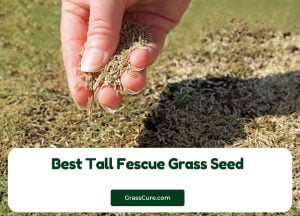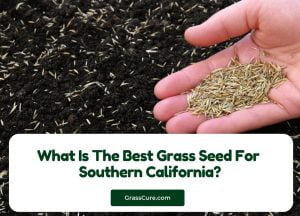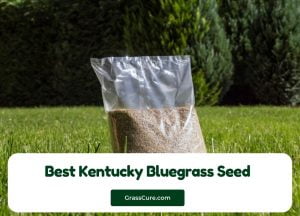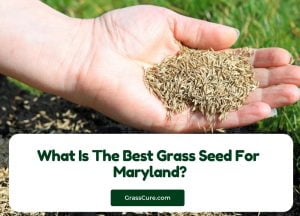To get the best grass seed for New England, you need to pay close attention to the weather. The New England region encompasses New Hampshire, Maine, Connecticut, Vermont, Road Island, and Massachusetts. This is typically known as the USDA zones 3 through 7.
Similarly, the southern tip of Massachusetts is the warmest region in the zone. New England, Vermont, and New Hampshire are the coldest. Gardeners in these states can plant a variety of fresh, seasonal grass directly from the following seeds.
Contents
Kentucky Blue Grass
Kentucky bluegrass (Poa pratensis) is native to Europe and northern Asia and grows well in all New England states. The average leaf length is 3 to 4 inches, and the color is bright green. This grass does not grow well in the shade. During hot summers, watering is necessary to keep it green and healthy.
Besides, Kentucky Bluegrass is a cool seasonal herb that stays quiet during hot New England summers. In cool weather, grass grows under the soil roots, and rhizomes help fill in the lawn’s bare areas. The more you mow, the faster your growth will be. Bluegrass grows best in the full sun.
Moreover, the New England region, located in New Hampshire, Vermont, Maine, Massachusetts, Connecticut, and Road Island, includes USDA zones 3 through 7.
Similarly, the southern tip of Massachusetts is the warmest region in the region. New England, Vermont, and New Hampshire are the coldest.
This grass requires a lot of watering, and for people looking for a well-maintained lawn, it can be cut to 1/2 inch or less.
Check Kentucky Blue Grass Seed
Perennial Ryegrass
Ryegrass is similar to Kentucky bluegrass but more resistant to drought and heat. The leaves of this plant are actually bright green and gradually thinner towards the top. Perennial Ryegrass proliferates from seed and can withstand heavy traffic, so it is suitable for families and schools with children. This grass does not grow well in the shade.
Similarly, the Ryegrass is a seed that germinates quickly. Depending on the combination of purchases, you may see annual or perennial Ryegrass. It happens very quickly every year, but it dies in the first terrible frost.
Moreover, Perennial is coming soon and will not die. However, ryegrass varieties usually remain where they germinate. They have no shoots or roots underground, which helps fill in the bare area.
Besides, Ryegrass is similar to Kentucky bluegrass but more resistant to drought and heat. Similarly, this plant works best in dry soil and does not like wet growing conditions.
Bentgrass
Bentgrass (Agrostis) is the ideal lawn for lawns, lawns, or golf courses in New England. This grass requires a lot of watering, and for people looking for a well-maintained lawn, it can be cut to 1/2 inch or less. Curved glass has a blue tint. This herb can be grown directly from seeds, but gardeners need to fertilize it for them to settle.
Fine-Leaf Fescues
Fine leaf Fescues or Festuca is a thin leaf that grows well on shady New England lawns. This grass’s average height is 2-3 inches and will not stand up to heavy traffic. Fescue blades are thinner and narrower than other types of glass blades. This plant works best in dry soil and does not like wet growing conditions.
Fescues can withstand certain drying conditions. This grass grows in the sun and shade. It is also an herbal medicine in the cold season and is most effective in favorable weather conditions. This just fills the grass area.
Moreover, when buying a gradient blend, the proportion of fescue cream should be high. This does not mean he will live in the dark. Like all plants, grass needs sunlight for photosynthesis. If the lawn is too dense to grow, it is recommended to look for an alternative soil that can tolerate shade.
How to seed a lawn initially
Below are the detailed preparation and seeding instructions
- Measure the area and calculate the square meter (length x width).
- Optional procedure: Eliminate weeds and grasses using non-selective herbicides (weeds). However, sowing should be delayed for about 10 minutes. 5-7 days after applying such a product. Be careful not to use a complete plant killer.
- Rotate the area to remove all stones, roots, and weeds that may be preventing grass seed development.
- Coarse quality – rips and removes dirt, producing a reasonably flat area (no soft soil) on which seeds can be placed.
- Incorporate any necessary modifications into the soil to ensure the grass seeds sprout.
- Good grade: At this time, the quality should be level. There is no doubt in which direction the water will flow.
- Roll up the area with about 3/4 of a glass roller filled with water.
- Water gently. In case of blisters, remove the soil from high places and fill low ones.
- Distribute the grass seed mixture evenly over the area. Contact an expert to find the best blend for your site.
- After sowing the seeds, gently roll the area (empty container) to help place the bed on the ground.
- Wet the entire area and sprinkle salt, raisins, seed coats, or similar products over the place to retain moisture and increase seed germination.
Lawn Seeding Preparation
Core aeration is an essential part of the overall lawn management plan. It improves the penetration of water and nutrients, increases the soil’s oxygen content, and reduces the straw content.
Similarly, the addition of top dressing significantly improves the soil’s chemical properties and structure, improving the fertilizer’s performance.
Moreover, if your lawn has high organic content or compression issues and you just want to improve the physical structure, consider adding porous ceramics to improve soil structure and root zone performance. For best results, the surface decoration material should be drawn after construction.
FAQs:
Q1: What is the best grass seed for New England’s climate?
A1: The best grass seed for New England’s climate is a cool-season grass blend. Fescue, Kentucky Bluegrass, and Perennial Ryegrass are popular choices. These grasses can thrive in the region’s variable climate, with cold winters and moderate summers.
Q2: Is Kentucky Bluegrass a good choice for New England lawns?
A2: Yes, Kentucky Bluegrass is an excellent choice for New England lawns. It’s known for its lush appearance and can thrive in the cooler climate of the region. However, it may require extra care during hot and dry periods.
Q3: What grass seed is best for shaded areas in New England?
A3: For shaded areas in New England, Fine Fescue grasses like Creeping Red Fescue and Chewings Fescue are excellent choices. These grasses tolerate lower light conditions and can grow well in the shade under trees and buildings.
Q4: Can I use a warm-season grass in New England?
A4: Warm-season grasses like Bermuda or Zoysia are not typically recommended for New England because they are better suited to warmer climates. Cool-season grasses are better adapted to the region’s climate, which includes cold winters and mild summers.
Q5: How do I prepare my lawn for seeding in New England?
A5: To prepare your lawn for seeding in New England, start by removing any existing weeds and debris. Aerate the soil to improve seed-to-soil contact. Choose a high-quality grass seed blend suitable for your area, spread it evenly, and water the area thoroughly. Follow a regular watering and maintenance schedule to ensure successful grass establishment.
Q6: When is the best time to plant grass seed in New England?
A6: The best time to plant grass seed in New England is in the early fall (late August to early October) or in the spring (late April to early June). These times offer the right soil temperature and moisture levels for optimal seed germination and growth.
Q7: What should I look for when buying grass seed for my New England lawn?
A7: When buying grass seed for your New England lawn, look for a high-quality blend that includes a mix of cool-season grasses suitable for the region. Check the label for information on the grass types and their percentages to ensure they match your lawn’s needs.
Q8: How often should I water newly seeded grass in New England?
A8: Newly seeded grass in New England should be watered regularly to maintain consistent soil moisture. Water lightly multiple times a day, aiming for around 1 inch of water per week. Be cautious not to overwater, as this can lead to issues like disease and poor grass growth.
Q9: Can I mix different grass seed types for my New England lawn?
A9: Yes, you can mix different grass seed types for your New England lawn to create a custom blend that suits your specific needs. Ensure that the grass types you choose are compatible in terms of growth habits, shade tolerance, and climate adaptation.
Q10: Are there any low-maintenance grass seed options for New England lawns?
A10: Yes, some low-maintenance grass seed options for New England lawns include Fine Fescue blends. These grasses require less mowing and maintenance compared to Kentucky Bluegrass or Perennial Ryegrass, making them a good choice for those seeking a low-maintenance lawn.
Conclusion
It is always good to mix the seeds with a grass seed mixture. The main reason is that if a pest enters your garden, loves grass, and destroys your lawn, you have at least this mixture, and rye and fescue survive. Besides, you can sow at any time of the year, but planting under adverse conditions usually reduces the proportion of germinated seeds.







